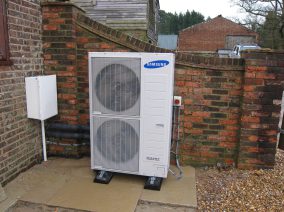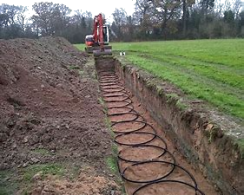Heat Pumps
With the UK government launching a number of incentives to improve the energy efficiency of your homes, air and ground source heat pumps are an ideal solution to reduce a property’s carbon footprint.
A heat pump takes the available heat from the ground or air surrounding a property and increases it to a more useful temperature for use in the home. This renewable source of heat can be used to create warm air or water (for space and central heating) as well as hot water (for both central heating and domestic hot water supply). It achieves this by using the same principle that allows a fridge to cool your groceries but in reverse. It is very important to bear in mind that heat pumps can only work efficiently when the property is well insulated. A heat pump operates in the following way:
The source of heat, which can be outside air or water which is contained within ground collectors, is either blown or pumped over the heat exchange surface of the outside part of the heat pump. This heat (although cold in comparison to a home’s internal air) is warm enough to cause the special refrigerant liquid to evaporate and turn into a gas. This gas is then put through a compressor which causes its temperature to rise. The heated gas is passed over the internal heat exchange surface. This heat can then be either blown around a property or be transferred into a home’s central heating or hot water system. The gas falls in temperature as the heat is transferred into the home and subsequently returns to a liquid state. The refrigerant returns to the outside heat exchange surface and the process repeats itself until sufficient heat is passed into the home.
How much do they cost and how efficient are they?
Air source heat pumps are about 500% efficient and some have the advantage of providing cooling in the summer. An air source pump is an alternative way to heat your home. It will enable you to generate your own renewable heat and potentially save money on your energy bills while reducing your carbon footprint.
An air-to-water heat pump typically costs between £10,000 and £18,000 for a typical detached dwelling. The costs vary depending on the size of the property, the size of the heat pump, the complexity of the system and whether you choose simple or advanced controls (for example a weather-compensated thermostat). You may also need to allow for the cost of upgrading your radiators or installing under floor heating because air sourced heat pumps tend to run at a lower temperature than typical domestic heating systems. This can cost several thousand pounds.
However Daikin, Samsung and Vattenfall now have a high temperature heat pump which can achieve 70 degrees flow line temperatures which removes the requirement to upgrade radiators or install underfloor heating. However these sytstems require much larger buffer water storage tanks typically 1.5 metres high and weighing up to 300 kg.
Both high and low temperature heat pumps also have the advantage of providing cooling via a reversible indoor unit (Hydro-box) which can be used to direct cooled water to heat pump convectors or fan coil units which is something you may well appreciate in ten years time.
Ground source heat pumps are up to 400% efficient and can provide low cost, low carbon, heating and hot water and can be used with under floor heating systems. Ground source heat pumps are generally more expensive due to the complexity of the installation.
The cost of a ground sourced heat pump can vary between £20,000 - £35,000 depending on the size of the property, the type of collection system and the complexity of the system. There are two types of ground source heat pumps - one having a horizontal underground collection system buried in trenches 1200 mm underground, and one using boreholes which can be anything from 80 – 140 metres deep.
You would need to allow an area in your garden of about five times the floor area of your house for a horizontal collector system. As a general rule, 50m2 of ground will need to be trenched per kilowatt capacity of the heat pump. Therefore a 12kW heat pump would typically require around 600m2 of clear ground. For a borehole system you should allow roughly one borehole up to 120 metres deep for every 50 square metres of floor space. Boreholes generally need to be spaced about 6 metres apart. A horizontal system tends to be significantly cheaper than boreholes.
While ground sourced heat pumps generally cost much more to install, ground sourced heat punps have much lower running costs because the temperature of the ground is more consistent than the air, meaning that on cold days a ground sourced heat pump does not have to work as hard as an air sourced heat pump to generate the same amunt of heat.
Ground source heat pumps can help you save between £800 and £1500 per year on your heating bill when replacing an old electric system (not a gas fired system). However the payback period is difficult to predict. This is because it depends on how efficiently your system works, the type of system you're replacing and how well your home is insulated. If you’re replacing an average gas fired heating system, a ground source heat pump is unlikely to save much on your annual bill in comparison but it improves your carbon footprint.
From 1st April 2022, the new Boiler Upgrade Scheme (BUS) comes into effect replacing the Renewable Heat Incentive (RHI). Under the new Boiler Upgrade Scheme the government will provide £5,000 towards the cost of a new Air Sourced Heat Pump and £6,000 towards the cost of a new Ground Sourced Heat Pump.
Recently heat pumps have made several technological advances in different areas including fan motors, refrigerants, compressors, coils, and the use of dual sources from both ground and air. Dual source heat pumps (DSHP) can draw heat from either the air or the ground, depending on which is most efficient at the time, making it much more effective than traditional heat pump models. New heat pumps are also built with “dual-speed” or “variable-speed” motors to maximize comfort and electricity savings.



